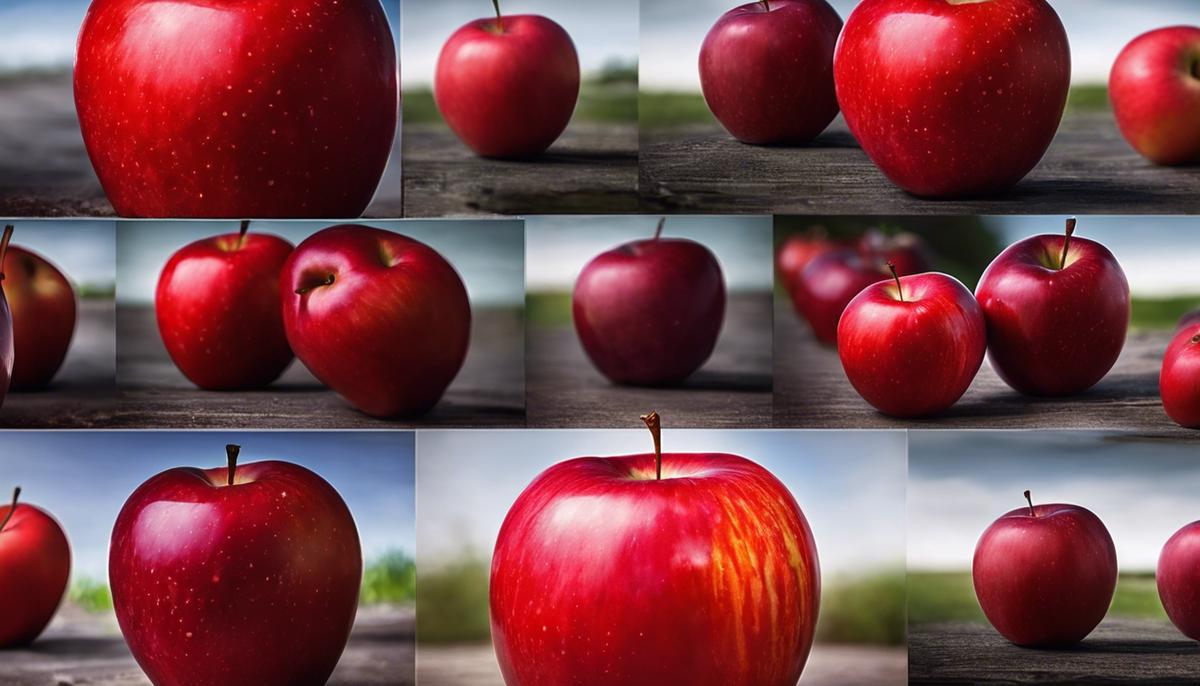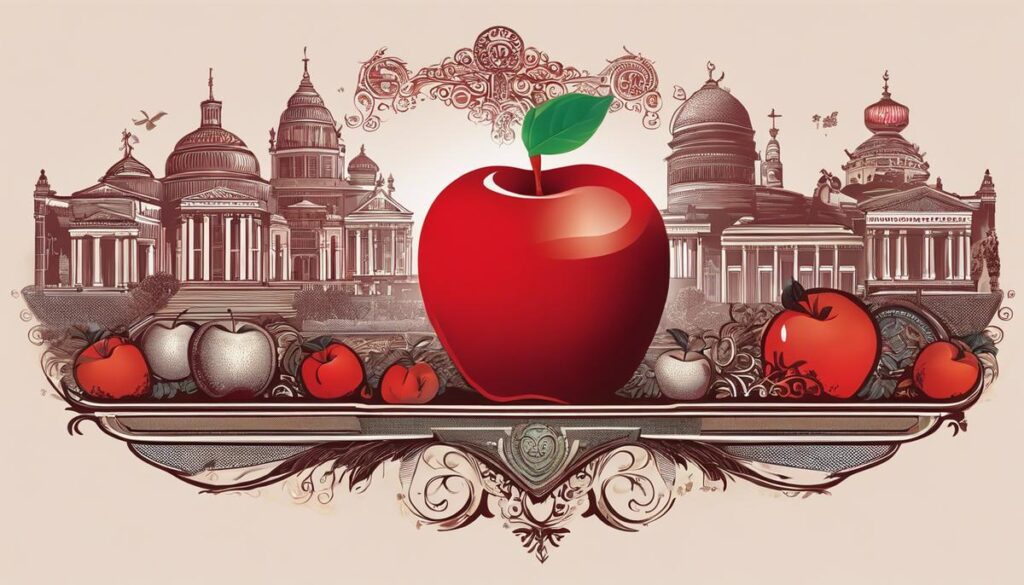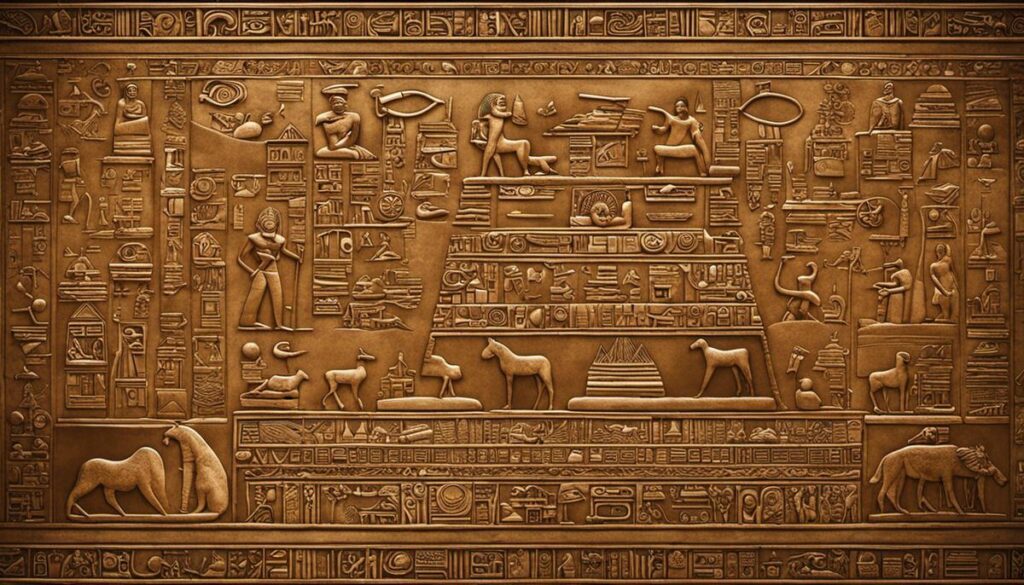Red apples, vibrantly hued and tantalizing, are a familiar entity in our daily lives, playing a deep-rooted part in various cultures, mythologies, and psychological frameworks. Their rich symbolism ranges from representing knowledge, as in Greek mythology, to marking temptation in Christian theology. Nonetheless, what does it mean when these symbolic fruits invade the landscape of our dreams? This piece goes beyond the surface to unravel the intricate layers of meanings concealed within the simple red apple dream. We explore the historical and cultural significance of apples, probe into prevailing psychological theories on dream analysis, and navigate the territory of color symbolism in dreams. Furthermore, we delve into personal factors molding dream interpretation and contextualize red apples as dream symbols themselves.
Symbolism of Red Apples in Cultures
Red Apples: A Trans-cultural Historical Symbolism
A profound emblem of health, temptation, wisdom, and divine providence, the red apple has been intricately woven into the cultural fabric of numerous societies. This article seeks to pull back the veil on this enigmatic symbol, divulging the rich historical symbolisms associated with the red apple across various cultures.
In Western civilizations, the red apple’s metaphoric significance has been historically influential. The apple as a metaphor for temptation is deeply ingrained in Judeo-Christian tradition, often misconstrued as the forbidden fruit in the Garden of Eden. Though the Bible makes no specific reference to apples, the Latin word ‘malus’ connotes both ‘apple’ and ‘evil,’ thereby aligning the fruit with temptation and sin.
Moreover, the auditory resemblance between ‘malus’ (apple) and ‘Malum’ (evil), encapsulates a linguistic hint at the allegorical connection. In Greek mythology, the apple appears as an emblem of discord, following the account of the golden apple presented to the fairest among the goddesses marking the genesis of the Trojan War.
The red apple has also presented as a symbol of wisdom and enlightenment. Examining Norse mythology, Idun, the goddess of youth, carried apples that maintained the gods’ immortality, indicating the apple’s signification of eternal wisdom. Aligning with this symbol of wisdom, the apple often appears in iconography surrounding Sir Isaac Newton to exemplify his revolutionary insight about gravity.
Eastern cultures depict a unique parallel interpretation of the red apple. Chinese folklore equates the apple with peace, owing to the phonetic similarity between ‘apple’ (píngguǒ) and ‘peace’ (píng’ān) in Mandarin. In addition, apples presented as gifts on Christmas Eve, called ‘Peace Apples’, extend wishes for tranquility and safety.
Diverse Native American cultures attribute sacred connotations to the red apple. For the Algonquin tribes, apples symbolize love and respect, often involved in tribal ceremonies. Yet in Hopi tradition, the apple figures as a solar emblem linked with the sun goddess Spider Woman, indicating activity and life-sustaining energy.
Despite the contextual variations in symbolism within different cultural landscapes, the red apple consistently presents as a metaphoric device carrying profound meaning. From the archetypal temptation rendered by Western civilizations to the expression of peace in Chinese culture, the symbolism of the red apple traverses the globe, offering a transformative lens to perceive shared human experiences.
Through careful examination and understanding, the ordinary red apple is illuminated in extraordinary ways. The symbolisms it carries across cultures are ultimately testaments to the inherent human propensity to seek meaning and narratives in the natural world around us. Thus, the red apple transcends its role as a mere fruit, ennobling itself as an enduring metaphor in the shared cultural imagination of humankind.

Psychological Theories on Dream Analysis
“Dream Analysis: A Journey Into the Psyche’s Subconscious Theater”
Dreams have been a source of fascination both to ancient and modern societies, reaching the depths of our collective conscious through their symbolic, surreal landscapes. They give us a window into the deepest and most enigmatic corners of the human psyche, offering glimpses of hidden thoughts, repressed emotions, and potential future aspirations. This raises the significant question: What do major psychological theories propose about the process and significance of dream analysis?
The theory of psychoanalysis, pioneered by Sigmund Freud, is one of the earliest and most recognized models of dream analysis. Freud postulated that dreams serve as the accidental expressions of often repressed desires, fears, and traumas. They are, in essence, the “royal road” to the unconscious. According to Freud, the analysis of the complex symbology of dreams—much like the metaphor of the red apple—can unravel insights into the hidden spheres of the dreamer’s psyche, thereby aiding in psychotherapy and self-understanding.
Carl Gustav Jung, a student of Freud but later a dissident, proposed a contrasting view of dreams. Jung’s theory of archetypes, the collective unconscious, and individuation provide an unconventional lens for dream interpretation. Just as the symbolism of the red apple transcends cultural boundaries, Jung postulates that certain dream symbols are universal, stemming from a collective unconscious shared across all humanity. These symbols, or archetypes, are conduits into understanding not just personal subconscious desires but also broader societal and historical trends ingrained within all of us.
Cognitive theorists, on the other hand, propose a different perspective, emphasizing the link between dreams and information processing. They propose that dreams are a cognitive simulation, a realm where the brain integrates and processes the vast array of information received during waking hours. Unlike the apple’s firm symbolism rich with cultural and historical associations, dreams’ significance in this view lies not in their content but in the mental activities they instigate: problem-solving, emotional processing, and memory consolidation.
Lastly is the activation-synthesis model borne out of neuroscience research by Hobson and McCarley. This perspective diverges from the symbolic emphasis by proposing that dreams are merely the random byproduct of neural firings (activations) in the brain during sleep, which the brain subsequently tries to synthesize into a coherent narrative. Unlike the intentional metaphor symbolized by the red apple, dreams in this view are spontaneous and devoid of inherent meaning, yet can be woven into potentially significant narratives by the brain’s storytelling tendencies.
In conclusion, just as the red apple can be perceived through various transformative lenses, such as temptation, wisdom, or peace, dreams too can be interpreted through diverse theoretical perspectives. Each suggests different routes to delve into the mysterious realm of our sleeping minds, and each carries its own implications for personal and societal comprehension of the profound phenomenon of dreams. Just as our understanding of the red apple’s symbolism deepens and enriches our engagement with the world, so too does exploring the theories of dream analysis deepen our understanding of the complex theater of our own minds. Dreams, in their different theoretical guises, are psychological artifacts of profound significance, not just longing looks into our subconscious but profound probes into our human condition.

Color symbolism in dreams
Moving beyond the cultural implications of color, particularly the hue of the red apple, in real-world narratives, it is essential to delve into the fascinating realm of dreams. Dreams are glimpses into the dark crevices of the human psyche, providing enlightenment about deepest fears, desires, experiences, and memories that might not surface in conscious understanding. Color, as a manifestation of these subconscious elements, carries profound symbolism in dreams, albeit tantalizingly elusive to unravel completely.
The Swiss psychoanalyst Sigmund Freud was instrumental in crafting the earliest comprehensive framework for dream analysis. Freud postulated that dreams serve as the royal road to the unconscious, revealing disguised desires and unresolved conflicts stemming from childhood. He argued that manifestations in dreams, such as colors, serve as symbols of purposes, often attached to sexual or aggressive impulses. Here, color can be conjectured to bear connotations synonymous with societal understandings, subject to the individual’s personal experiences.
Carl Gustav Jung, a student of Freud, diverged from his teacher’s sexual symbol-driven theory, focusing on the wider pantheon of human experiences. A cornerstone of Jung’s dream analysis is the notion of archetypes, universal symbols shared across humanity, ingrained in a collective unconscious. In this framework, color in dreams transcends personal symbolism, tapping into collective narratives. Furthermore, each color also embodies a unique characteristic, indicating various psychological states; for instance, red may entail both passion and danger.
Cognitive theories of dreams, although less focused on symbolic interpretations, contemplate color as collateral to the internal information processing. Dreams are seen as extensions of waking thought processes, where information and experiences get catalogued, assimilated, and integrated. Color can thus be seen as a cognitive feature adding richness and detail to this mental simulation, extending its experiential quotient.
The Activation-Synthesis model, introduced by J. Allan Hobson and Robert W. McCarley, places dreams as a byproduct of random electrical brain impulses, rather than a direct reflection of subconscious thoughts or emotions. However, even in this seemingly random paradigm, the interpretation of color in dreams holds firm, as the brain attempts to make sense of the scattered bursts of images and sensations.
Various theoretical perspectives underscore the importance of interpreting color in dreams, drawing upon rich symbolism to bridge the gap between conscious and unconscious cognition. Each interpretation could unfold significant implications pertaining to personal insights, mental health, or at a broader level, social and cultural comprehension.
Dreams, in their inherent visual and symbolic richness, often hint at the enigmatic undercurrents of our psyche. They remain psychological artifacts of the highest order, encompassing personal and collective experiences and emotions. Understanding the role of color in dreams is analogous to unraveling the threads of this intricate psychological tapestry. As we continue to break ground in this exciting area of research, we not only deepen our understanding of human cognition but also uncover the sheer authenticity of our existence expressed through the hue-infused landscapes of our dreams.

Photo by julianhochgesang on Unsplash
Red Apples as Dream Symbols
Infusing the practice of dream interpretation with cultural metaphorical understandings, it seems pertinent to delve into the symbolism of red apples within this framework. The expansive cross-cultural significances of this specific symbol, colored by various traditions and mythologies, intersect with the realm of dreams, forming a complex tapestry of psychosocial interpretations.
In the realm of dreams, the psychoanalytical theories of Sigmund Freud stand as seminal texts. Freud emphasized the concept of dreams as a deep dive into the unconscious mind. Applying Freud’s framework to the symbol of a red apple, it could implicitly signify suppressed desires or unconscious feelings; the forbidden fruit symbolizing emotions kept at bay in the conscious mind. Freud’s inherently sexual interpretation of apples as symbols of temptation could translate into a signal of repressed sensuality or unfulfilled desires in the dream realm.
Contrasting Freud’s approach is Carl Gustav Jung, who inclines towards archetypes and the collective unconscious. Here, the red apple could symbolize shared experiences of humanity, tapping into the wisdom of many. The apple’s connection with knowledge and enlightenment – in Norse mythology and Newton’s tale, for instance – may emerge as a subconscious call for wisdom, a discovery, or an impending enlightenment.
Cognitive theories offer fresh perspectives suggesting that dreams are information-processing activities. Partaking in a red apple in dream-imagery may be the mind’s way of decoding experiences from waking life that pertain to temptation, wisdom or discord, echoing cultural significances associated with the fruit. From a cognitive perspective, the interpretation of a red apple could give valuable insights into unresolved concerns or blatant focus areas.
Meanwhile, the Activation-Synthesis model argues that dreams are a random product of brain impulses during rapid eye movement sleep. Consequently, appearance of a red apple could potentially be an incidental, arbitrary activation of neural patterns tied to vision, conveying little to no symbolic meaning.
However, even within this randomness, color plays an integral role in dreams’ symbolism. The redness of the apple becomes as significant as the fruit itself. Red carries intense emotions, ranging from blood and danger to love and passion. Consequently, the color of the apple in dreams might be interpreted as a vibrant sign of stimuli, explosive emotions or impactful experiences.
Interpreting symbolisms in dreams often impacts personal development, mental health and societal comprehension. In psychotherapy, understanding a recurrent red apple in someone’s dream could be instrumental in deciphering one’s emotional state, aiding constructive navigation through personal challenges. Moreover, as dreams reflect personal experiences and the collective unconscious, an interpretation of symbols like the red apple could offer a means to empathize with diverse cultural narratives and broader human experiences.
In summation, the vast array of theoretical perspectives casts dreams, their interpretation and symbolism, under different lights. While interpretations vary from individual to individual, influenced by personal experiences and cultural background, the repetitive symbolism of a red apple in dream-imagery is undeniably rich. Far from being mere psychological phenomena, dreams weave around themselves a cloth of complex social, cultural, and psychological fibers, begging to be unraveled by the keen observer.

Personal Factors in Dream Interpretation
Drawing upon the robust cultural and psychological associations attached to the red apple, and recognizing dreams as potent conduits for the subconscious, this article explores the intriguing intersection of experience, psychology, and dream interpretation.
Emblematically, a dream featuring a red apple may generate divergent interpretations, pivoting on the dreamer’s individual experiences, psychological state, and cultural background. A dream analysis from Sigmund Freud’s psychoanalytic perspective may focus on an individual’s suppressed desires and unconscious feelings since Freud often perceived dreams as wish fulfillment. Hence, if a person nurtures a subconscious desire or harbors guilt due to an ‘original sin’, the red apple may surface in their dreams, resonating with its Judeo-Christian signification as the fruit of temptation and knowledge.
Markedly altering this trajectory, Carl Gustav Jung would likely direct attention to the dreamer’s collective unconscious. He might regard the red apple as an archetype that echoes universal narratives of wisdom, enlightenment, or peace, depending on the dreamer’s psychic tuning. The dreamer’s psychological disposition could further clarify the dream’s message – a calm and peaceful mental state might interpret the apple as a symbol of peace and tranquility in alignment with Chinese symbolism, while someone in the throes of intellectual curiosity might interpret the apple as the fruit of enlightenment.
In contrast to these psychoanalytic theories, cognitive psychologists consider dreams to be extensions of information-processing activities conducted while awake. With this lens, the red apple dream is interpreted as an encapsulation of daily experiences or memories, with the red apple dream symbol translating specific cognitions. Therefore, a farmer growing apples may dream about the fruit merely as an element of their waking reality, and not as a manifestation of suppressed desires or collective archetypes.
Letter to the divergent psychoanalytical approaches and cognitive theories, the Activation-Synthesis model hypothesizes that dreams emanate from random brain impulses generated during sleep, refuting the need for profound interpretation. Consequently, the model’s proponents would likely view a red apple dream as an arbitrary byproduct of neural processes, devoid of specific individual or cultural significations.
Despite such theoretical disparities, all interpretations converge on one shared premise: the psyche of the dreamer is pivotal. Consequently, interpreting color in dreams becomes an essential element of self-understanding. The vibrant hue of a red apple dream may induce feelings of passion, intensity, or even danger, which further layers the interpretation process. Moreover, deciphering these colors and symbols in one’s dreams may offer invaluable insight into one’s emotional health and mental well-being.
In broader societal terms, dream interpretation, underscored by color significance, can mandate a deeper understanding of collective emotions, experiences, and cultural nuances in our diverse world. As psychological artifacts, dream symbols like the red apple manifest both personal experiences and collective cultural influences, thereby wielding potential as tools of empathy and cross-cultural comprehension.
Unveiling the symbolic depths of dreams can be likened to unraveling a psychological tapestry, woven thread by thread with personal experiences, emotional states, and collective narratives. A red apple may just be a red apple for some, but in the theatre of dreams, it is a spotlight that illuminates the often-obscure interplays between individuals’ inner worlds and their societal beacons. The precise interpretation ultimately emerges from the complex alchemy of personal experience, psychological condition, collective symbolism, and theoretical lens.

Decoding the language of dreams is a unique blend of universal symbolism and individual interpretation, a blend that rings true while interpreting red apple dreams. The color and the fruit both have layered meanings, steeped in cultural and historical symbolism, crafted by psychological theories, and further molded by personal context. A red apple in a dream could thus be a symbol for knowledge, temptation, or abundance, or it could hold an entirely different meaning, catered to the individual’s experiences. Therefore, while this exploration illuminates potential interpretations of red apple dreams, the ultimate understanding hinges on the dreamer’s psyche, emotional state, and life experiences. Unlocking the full meaning of a dream, indeed, is rather like biting into a red apple – beneath the vibrant skin, a plethora of nuanced flavors awaits.







